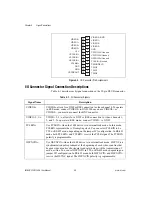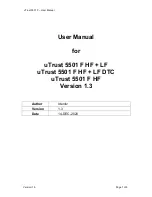
Glossary
©
National Instruments Corporation
G-5
dynamic range
The ratio of the largest signal level a circuit can handle to the smallest
signal level it can handle (usually taken to be the noise level), normally
expressed in decibels.
E
EEPROM
Electrically erasable programmable read-only memory. ROM that can be
erased with an electrical signal and reprogrammed.
external trigger
A voltage pulse from an external source that triggers an event such as A/D
conversion.
F
field
For an interlaced video signal, a field is half the number of horizontal lines
needed to represent a frame of video; the first field of a frame contains all
the odd-numbered lines, the second field contains all of the even-numbered
lines
FIFO
First-in first-out memory buffer. The first data stored is the first data sent
to the acceptor; FIFOs are used on IMAQ devices to temporarily store
incoming data until that data can be retrieved.
flash ADC
An ADC whose output code is determined in a single step by a bank of
comparators and encoding logic.
frame
A complete image. In interlaced formats, a frame is composed of two fields.
front porch
The area of a video signal between the start of the horizontal blank and the
start of the horizontal synchronization signal.
ft
Feet.
function
A set of software instructions executed by a single line of code that may
have input and/or output parameters and returns a value when executed.
G
gamma
The nonlinear change in the difference between the video signal’s
brightness level and the voltage level needed to produce that brightness.














































